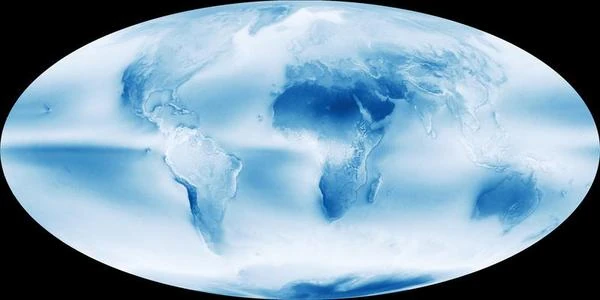
Image description: This map of cloud cover represents an "average cloud cover" of all NASA satellite observations between July 2002 and April 2015. The colors range from dark blue (no clouds) to light blue (some clouds) and white (frequent clouds). There are three major "bands" where the Earth's skies are often cloudy. But in some parts of the planet, the landscape favors deserts (Tibetan Plateau desert, Death Valley desert in California east of the Sierra Nevada, Atacama Desert in South America). Image Credit: NASA Earth Observatory by Jesse Allen and Kevin Ward, using data provided by MODIS Science Team, NASA Goddard Space Flight Center.
Satellite observations and astronaut photographs show that clouds dominate the Earth's sky.
From water vapor to enormous cloud structures, the sky is on average obscured by ≈67%, this astonishing figure is the result of a decade of observations and demonstrates that the Earth's surface is generally covered by clouds.
Cloud cover is particularly important over the oceans, only 10% of the sky is completely clear of clouds at any given time over the oceans. While on the continents, 30% of the skies are completely blue.
The cloudy aspect of the Earth is unequivocal on this global map redrawn from data collected by scientific observation instruments onboard the satellites of NASA's EOS (Earth Observing System) program, including the Terra satellite, then Aqua, then Aura launched in 2004 and still operational in 2015. The various instruments, spectrometers, radiometers, sounders, and sensors take a complete image of the Earth every 1 or 2 days. They are designed to provide global measurements, such as variations in cloud cover or the radiation budget.
Interpreting these data is delicate because this average in the distribution of clouds does not exhaustively illustrate all the days of the period nor the seasonal variations nor the altitude of the clouds nor the presence or absence of several layers of clouds. However, it correctly informs us about the very cloudy regions compared to the very sunny regions seen by MODIS (Moderate-Resolution Imaging Spectroradiometer). The sensitivity of this instrument is slightly different depending on the environments (over the ocean, on the coasts, over deserts, or over vegetated land surfaces).
N.B.:
MODIS detects clouds better over the dark surfaces of oceans and forests than over bright ice surfaces. Similarly, cirrus clouds are more difficult for sensors to detect than thick layers of cumulus.
There are three major "bands" where the Earth's skies are often cloudy.
The first cloud band is a narrow equatorial band, crossing the Pacific, South America, the Atlantic, Africa, and Indonesia. This shows the warm and humid air of the equatorial zone colliding with the cooler air of the tropical zones. In this thermal exchange, the warm and humid air rises, cools, and condenses into clouds producing thunderstorms in an area known as the Intertropical Convergence Zone (ITCZ).
The other two cloud bands are located at mid-latitudes, at 60 degrees North and 60 degrees South. They are due to the thermal shock between the circulation of polar air and the circulation of air at mid-latitudes which rises, cools, and condenses into clouds. Conversely, descending air inhibits cloud formation. Thus, between 15 and 30 degrees north and south of the equator, descending air prevents cloud formation and favors deserts that can be seen on this map at these latitudes.
We also notice a tendency for cloud formation off the west coasts of continents, particularly off the coast of South America, off the coast of Africa, and off the coast of North America. This is due to the surface water of the oceans being pushed westward away from the western border of the continents due to the Earth's rotation on its axis.
In this process called upwelling, cold water from the depths rises and replaces the warm surface water, which cools the air above the water. The humid marine air cools, the water vapor condenses into water droplets, forming low clouds called marine stratocumulus.
Stratocumulus clouds are the most common in the world; they cover about one-fifth of the Earth's surface. In some parts of the planet, the landscape favors deserts. Indeed, mountain ranges stop air currents, so rains tend to precipitate on the slopes. While on the other side of the mountain barrier, in the lee, deserts develop like the Tibetan Plateau desert north of the Himalayas, Death Valley located southeast of California east of the Sierra Nevada, and the Atacama Desert in South America located east of the Andes.